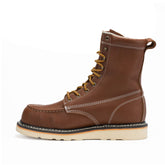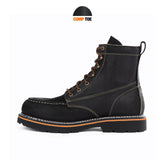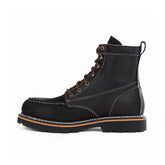Goodyear Welt Durability
THE TOP REASONS TO BUY GOODYEAR STORM WELT BOOTS
What is Goodyear storm welt?
Let’s start with the basics: what does “Goodyear storm welt” even mean?
Well, a “Goodyear welt” is when the sole of the shoe is wider than the upper. A leather rim (the “welt”) stretches from the bottom of the upper to the edge of the sole, and the sole is stitched to this leather rim. The welting process was invented by Charles Goodyear, Jr, son of the famous chemist who created the chemical process for hardening rubber called vulcanization. Vulcanization allowed rubber to be used in a variety of applications, but most notably in tires and footwear soles.
Goodyear welt comes in a few different variations, including a “hand welt”—which means the stitching is done by hand—and “storm welt”—which uses a wider leather rim and folds it upward against the upper for a more moisture-resistant seal.
1. Water resistance
Goodyear welt—and especially Goodyear storm welt—construction creates a tight seal to prevent water from getting into the shoe. This contrasts with another stitched shoe design called “Blake stitching.” In a Blake stitched shoe, the upper of the shoe is stitched directly to the sole. This creates pores in the sole where water can seep in. As a result, those who wear Blake shoes often complain about water getting into their shoes.
Goodyear welt construction adds an extra moisture barrier: the welt. Goodyear storm welt enhances that moisture barrier even further: by folding the welt, it doubles up the seal.
2. Durability
If you’ve owned both shoes made of synthetic materials and shoes made of leather, then you’ll be very familiar with the durability of leather shoes. Whereas a synthetic will often wear out within a year or two, leather shoes can last for a great many years. With a leather shoe or boot, the weak points become the construction and the sole. Either the upper starts to separate from the sole, or you wear out the tread. Goodyear welt solves these problems.
A welted sole shouldn’t ever separate from the upper. Instead of using adhesive or rubber cement, as stated, with Goodyear welt, the upper is secured to the sole with stitching. And Goodyear welt stitching is a genius design. It uses a series of double lock-stitches to ensure that if one stitch breaks, it won’t unravel the rest of the seam. And if for some reason the stitches do break, the seam can be restitched and repaired.
As for wearing out the tread on your sole, one great thing about Goodyear welt boots is that they can be resoled and repaired. Rather than throw out your boots when the tread wears out, you can just send your boots back to Duradero for a free resole. This adds years to the life of your boots.
In the end, investing in a pair of quality handmade boots will save you money overall. It can feel less expensive to buy cheap synthetics, but don’t forget that with synthetics you’re buying a new pair every year or so. That’s ultimately more expensive when you tally up the cost. Plus, all those synthetic shoes are piling up in landfills somewhere. Buying quality leather storm welt shoes and getting them re-soled is great for the environment because you produce less waste.
- Choosing a selection results in a full page refresh.






